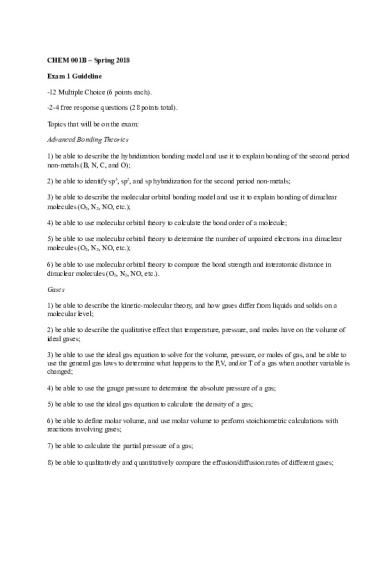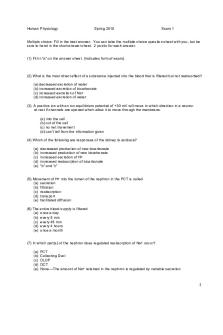Exam 1 Guide - Jack Eichler (Spring 2018) PDF

| Title | Exam 1 Guide - Jack Eichler (Spring 2018) |
|---|---|
| Course | General Chemistry |
| Institution | University of California Riverside |
| Pages | 2 |
| File Size | 94.1 KB |
| File Type | |
| Total Downloads | 1 |
| Total Views | 131 |
Summary
Jack Eichler (Spring 2018)...
Description
CHEM 001B – Spring 2018 Exam 1 Guideline -12 Multiple Choice (6 points each). -2-4 free response questions (28 points total). Topics that will be on the exam: Advanced Bonding Theories 1) be able to describe the hybridization bonding model and use it to explain bonding of the second period non-metals (B, N, C, and O); 2) be able to identify sp3, sp2, and sp hybridization for the second period non-metals; 3) be able to describe the molecular orbital bonding model and use it to explain bonding of dinuclear molecules (O2, N2, NO, etc.); 4) be able to use molecular orbital theory to calculate the bond order of a molecule; 5) be able to use molecular orbital theory to determine the number of unpaired electrons in a dinuclear molecules (O2, N2, NO, etc.); 6) be able to use molecular orbital theory to compare the bond strength and interatomic distance in dinuclear molecules (O2, N2, NO, etc.). Gases 1) be able to describe the kinetic-molecular theory, and how gases differ from liquids and solids on a molecular level; 2) be able to describe the qualitative effect that temperature, pressure, and moles have on the volume of ideal gases; 3) be able to use the ideal gas equation to solve for the volume, pressure, or moles of gas, and be able to use the general gas laws to determine what happens to the P,V, and/or T of a gas when another variable is changed; 4) be able to use the gauge pressure to determine the absolute pressure of a gas; 5) be able to use the ideal gas equation to calculate the density of a gas; 6) be able to define molar volume, and use molar volume to perform stoichiometric calculations with reactions involving gases; 7) be able to calculate the partial pressure of a gas; 8) be able to qualitatively and quantitatively compare the effusion/diffusion rates of different gases;
9) be able to explain the advantages and disadvantages of using hydrogen as a fuel in fuel cell vehicles, and the limitations in storing hydrogen fuel onboard a vehicle. Intermolecular Forces, Phases, and Phase Changes 1) be able to define the relationship between polar covalent bonds, dipole moments, and intermolecular forces, and be able to qualitatively compare the strength of intermolecular forces between different molecules; 2) be able to use the concept of intermolecular forces to predict and explain the nature of different physical properties for liquids and solids (boiling point, melting point, etc.); 3) be able to explain how phase changes occur on a molecular level; 4) be able to predict the relative boiling point or melting point of different substances, and explain why the boiling point or melting point of one substance is higher/lower than another substance; 5) be able to interpret phase diagrams and phase change diagrams; be able to calculate heat changes during the various phase changes that can occur in water; 6) be able to describe the difference between boiling and evaporation, and be able to interpret phase diagrams that are used to describe the distillation of a mixture of liquids; 7) be able to explain how fractional distillation is used to separate different kinds of petroleum based fuels.
You will be given a periodic table, a table of the redox activity series, and the following formulas, constants, and conversion factors on the exam: Bond order = [bonding electrons-antibonding electrons]/2 PV = nRT
R = 0.0821 L·atm/mol·K = 8.31 J/mol·K 1atm = 760mmHg = 14.7 psi
Gauge pressure = absolute pressure – atmospheric pressure Rate gas 1/Rate gas 2 = (mass gas 2/mass gas 1) 1/2 Ptotal = PA + PB +PC
PA = Xa·Ptotal
XA = moles gas A/moles total gas
q = ΔHfus/vap · moles
q = mass · C · ΔT
ΔHfus = 6.01 kJ/mol
ΔHvap = 40.67 kJ/mol
C (heat capacity) – will be given in problems if needed
*You will need to be able convert between Celsius and Kelvin, make mole-gram conversions, convert between L and mL, and identify formulas of compounds from names (and vice versa)....
Similar Free PDFs

1. Exam #1 - Version A - Spring 2018
- 14 Pages

Spring 2018 Homework 1
- 2 Pages

Midterm 1 Spring 2018, questions
- 13 Pages

SPH 1150 Spring 2018 (1)
- 7 Pages

CMS Practice Final Exam 2018 Spring
- 19 Pages

EXAM 3 Chapter 10 Spring 2018
- 7 Pages

PS1- Spring 2018 Solutions
- 3 Pages

Spring 2018 Exam2Review
- 20 Pages

Jack Roller Assignment 1
- 2 Pages

Exam 1 Spring 15 - fdafda
- 6 Pages

K303 Spring 2018
- 12 Pages
Popular Institutions
- Tinajero National High School - Annex
- Politeknik Caltex Riau
- Yokohama City University
- SGT University
- University of Al-Qadisiyah
- Divine Word College of Vigan
- Techniek College Rotterdam
- Universidade de Santiago
- Universiti Teknologi MARA Cawangan Johor Kampus Pasir Gudang
- Poltekkes Kemenkes Yogyakarta
- Baguio City National High School
- Colegio san marcos
- preparatoria uno
- Centro de Bachillerato Tecnológico Industrial y de Servicios No. 107
- Dalian Maritime University
- Quang Trung Secondary School
- Colegio Tecnológico en Informática
- Corporación Regional de Educación Superior
- Grupo CEDVA
- Dar Al Uloom University
- Centro de Estudios Preuniversitarios de la Universidad Nacional de Ingeniería
- 上智大学
- Aakash International School, Nuna Majara
- San Felipe Neri Catholic School
- Kang Chiao International School - New Taipei City
- Misamis Occidental National High School
- Institución Educativa Escuela Normal Juan Ladrilleros
- Kolehiyo ng Pantukan
- Batanes State College
- Instituto Continental
- Sekolah Menengah Kejuruan Kesehatan Kaltara (Tarakan)
- Colegio de La Inmaculada Concepcion - Cebu




